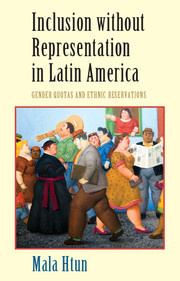Book contents
- Frontmatter
- Dedication
- Contents
- List of Tables and Figures
- Preface and Acknowledgments
- List of Acronyms
- 1 Introduction: Politics of Inclusion in Latin America
- 2 Women, Afrodescendants, and Indigenous Peoples in Elected Office
- 3 Gender Quotas: Why and How?
- 4 Indigenous Reservations and Gender Parity in Bolivia (written with Juan Pablo Ossa)
- 5 Political Inclusion in Colombia
- 6 Brazil: Combatting Exclusion through Quotas in Higher Education
- 7 After Quotas: Women's Presence and Legislative Behavior in Argentina (written with Marina Lacalle and Juan Pablo Micozzi)
- 8 Conclusion
- Appendix 1 Research Trips
- Appendix 2 Mechanisms of Inclusion
- References
- Index
6 - Brazil: Combatting Exclusion through Quotas in Higher Education
Published online by Cambridge University Press: 18 December 2015
- Frontmatter
- Dedication
- Contents
- List of Tables and Figures
- Preface and Acknowledgments
- List of Acronyms
- 1 Introduction: Politics of Inclusion in Latin America
- 2 Women, Afrodescendants, and Indigenous Peoples in Elected Office
- 3 Gender Quotas: Why and How?
- 4 Indigenous Reservations and Gender Parity in Bolivia (written with Juan Pablo Ossa)
- 5 Political Inclusion in Colombia
- 6 Brazil: Combatting Exclusion through Quotas in Higher Education
- 7 After Quotas: Women's Presence and Legislative Behavior in Argentina (written with Marina Lacalle and Juan Pablo Micozzi)
- 8 Conclusion
- Appendix 1 Research Trips
- Appendix 2 Mechanisms of Inclusion
- References
- Index
Summary
Brazil is home to the region's largest Afrodescendant population, longest tradition of race-based organizing, most institutionalized official system of data collection by skin color, and greatest (albeit recent) degree of state attention to racial inequality. Government agencies at all levels have introduced affirmative action programs to expand opportunities for nonwhites. Yet the state has eschewed candidate quotas or reserved seats. Instead, the principal form of affirmative action consists of admissions quotas in public universities aimed at poor Afrodescendants and other economically disadvantaged citizens. Starting in 2001, when the state legislature of Rio de Janeiro abruptly approved a 50 percent “social” quota and then a 40 percent race quota for two state universities, quota policies snowballed around the country. By 2012, when the national congress approved a law mandating quotas by class and race in all federal universities, 71 percent of all public universities already had affirmative action programs (Feres Júnior, Toste Daflon, & Campos, 2012).
As courts in the United States tightened the legal parameters surrounding consideration of race in university admissions, Brazil moved in the opposite direction. The Brazilian government's embrace of race as a category for public policy puts it at odds with its northern counterpart as well as with its own historical tendencies to deny the racialized nature of social inequalities. Official discourse and conventional wisdom denied the salience of race and insisted that discrimination revolved primarily around class. Why did the country suddenly seem to adopt an extreme, rigid form of affirmative action?
Brazil's quota policies may not be such a radical departure from its historic approach to race. Though the Afro-Brazilian movement fought for affirmative action and conceptualized quotas as a way to promote racial inequality, class criteria were actually more pervasive in the laws and policies eventually adopted. More universities have adopted quotas based on social class than on race, and the national law nests racial criteria within class criteria to preclude well-off blacks from taking advantage of the policies. Race is not an independently valid basis for affirmative action. It should be taken into account only after class.
This chapter accounts for the evolution of affirmative action policy in Brazil. I analyze the transition from the Cardoso era to the Workers’ Party administrations, explain the focus on higher education, and explore the relative weight of race- and class-criteria in affirmative action.
- Type
- Chapter
- Information
- Inclusion without Representation in Latin AmericaGender Quotas and Ethnic Reservations, pp. 121 - 137Publisher: Cambridge University PressPrint publication year: 2016



